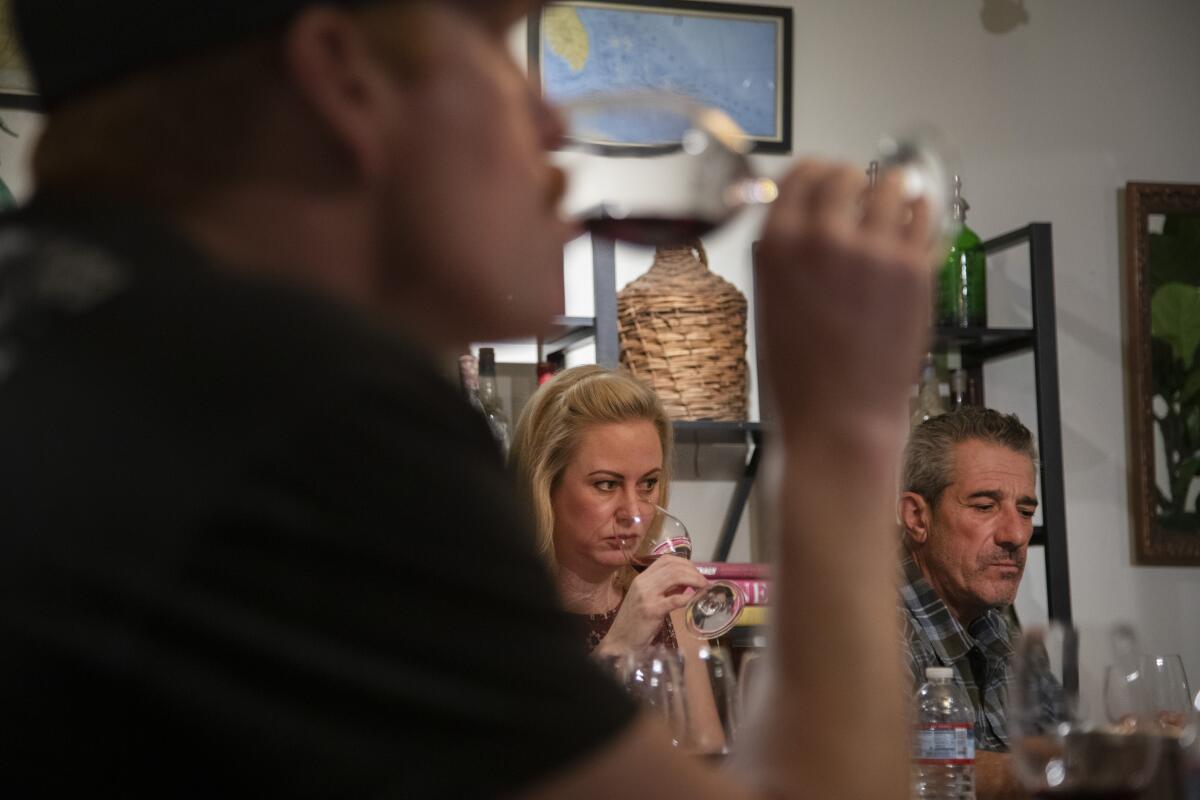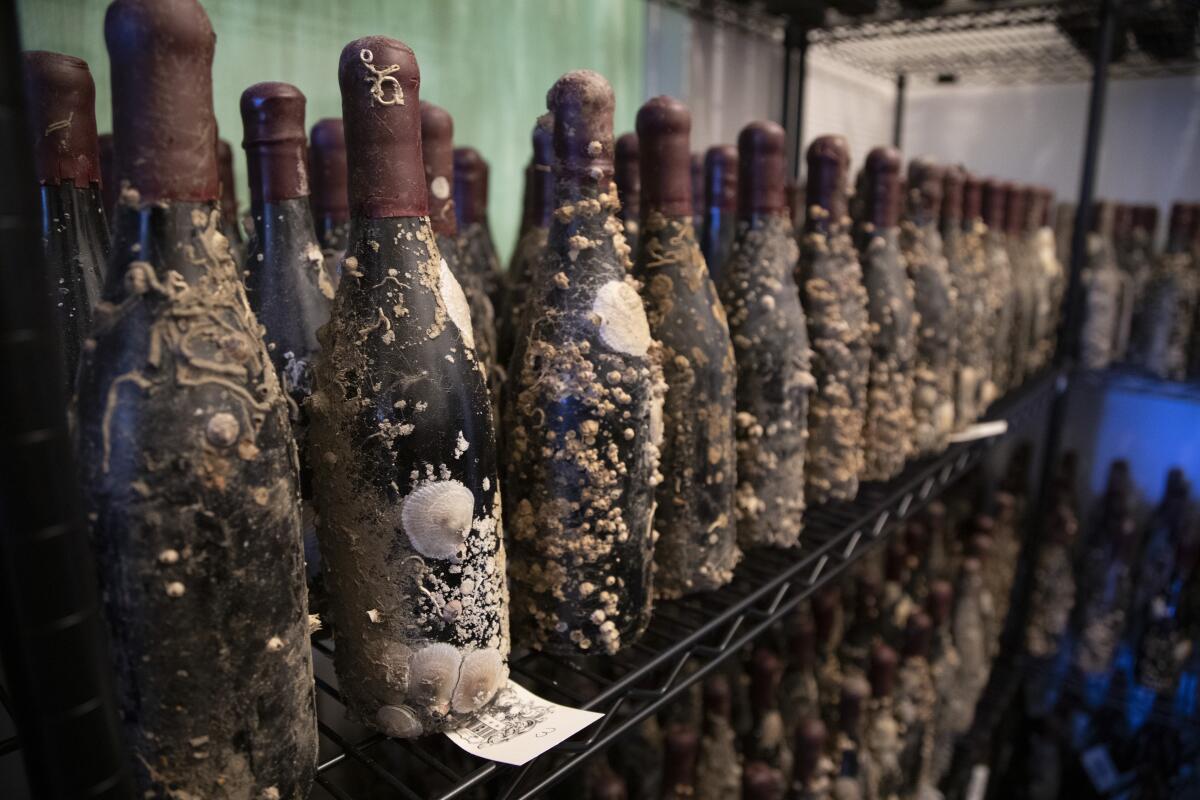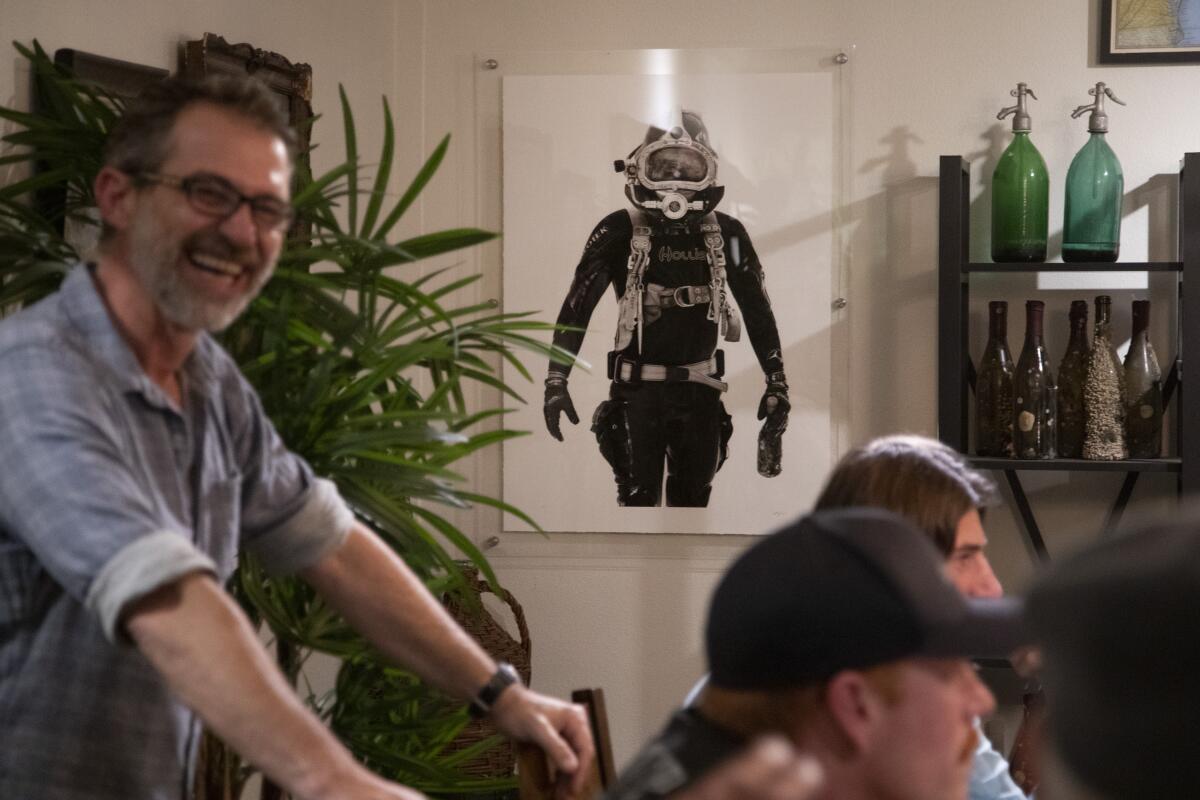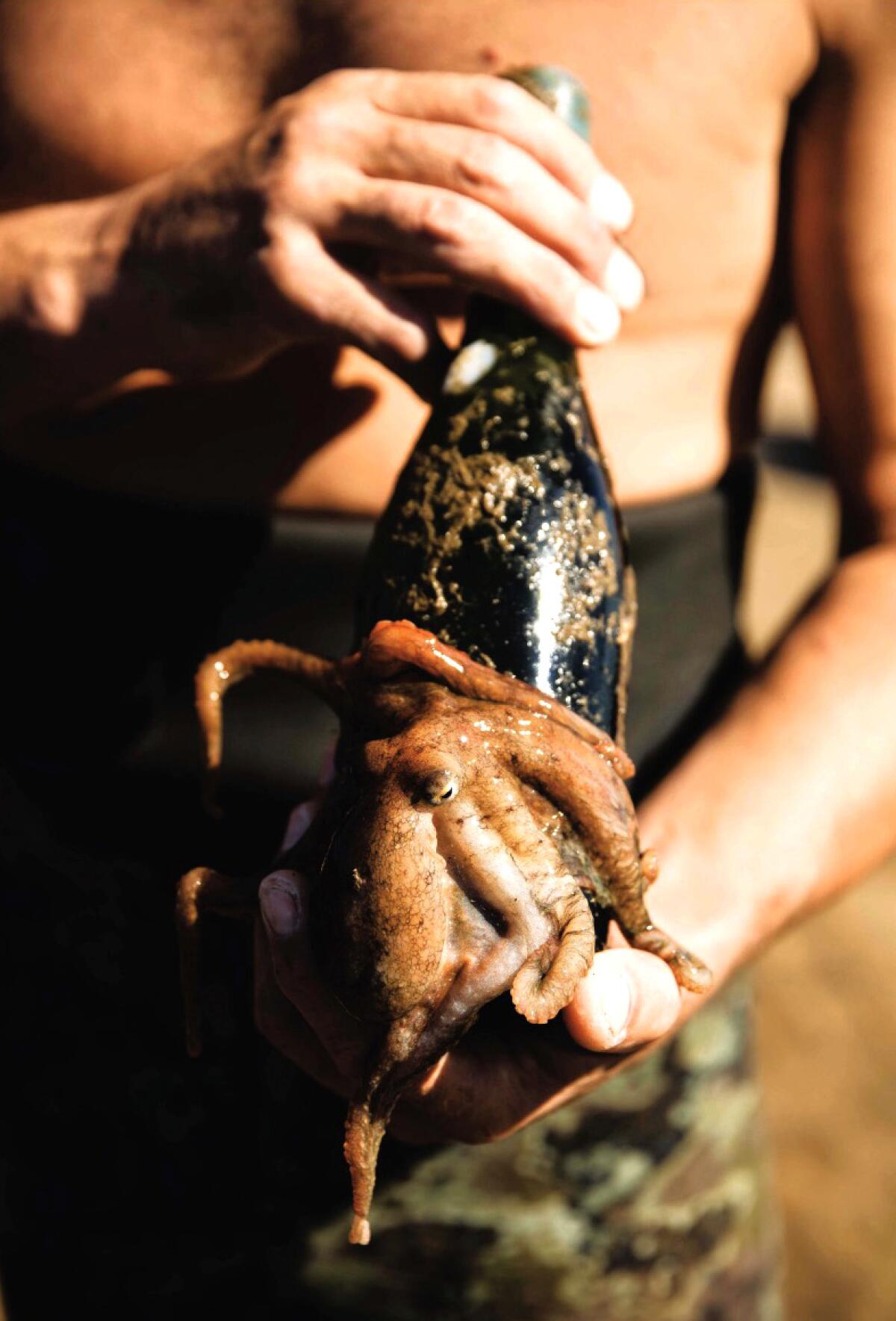Column: They say their ocean-aged wine is magic in a bottle. We put that claim to the test

We took our seats around a table. The wine was poured. The stakes were high.
Let’s call it the Great Santa Barbara Wine Tasting.
You may recall the case of the underwater wine locker, in which a company called Ocean Fathoms ran afoul of the California Coastal Commission for storing vino on the ocean floor a mile off Santa Barbara.
Put a cork in it, said the commission staff, which ordered Ocean Fathoms to haul hundreds of bottles of caged wine out of the surf.
But the wine is sublime, argued Ocean Fathoms, which disputes the commission’s finding that a Pinot plunge is strictly prohibited under the Coastal Act.
“But you can drill for oil,” said Todd Hahn, one of Ocean Fathoms’ owners, noting the recent catastrophic oil spill that fouled the Orange County coast.
If you had a wine spill, said Ocean Fathoms president Emanuele Azzaretto, people would flock to the beach, cups in hand.
A fair argument, but no new oil drilling off the California coast has been permitted in decades, and there are calls to mothball existing pumping operations.
But regardless of how the regulatory proceedings play out for Ocean Fathoms, I wanted to test the central claim. The owners insist that a bottle of wine stored on the ocean floor for a year or so tastes better than a bottle of the same wine traditionally stored in a cool, dark place on land.

How so?
Ocean Fathoms claims it’s all about seafloor temperature, darkness, pressure, and the gently swaying currents. And every bottle, they say, is a work of art, thanks to the mosaic of barnacles and other sea life attached to the glass.
As noted in my first column on this scheme, Susan Jordan of the California Coastal Protection Network was appalled that marine creatures including an octopus or two clung to the wine bottles in marketing photos.
And skeptics of the benefits of underwater storage were not hard to find, nor were they inclined to pay up to $350 for a bottle that would ordinarily sell in the neighborhood of $70.
A UC Davis professor of viticulture called it marketing voodoo aimed at rich people who want something in their collection to brag about.

A highly regarded online wine writer called it flat-out BS.
And yet ocean-water wine storage is happening in several countries, inspired in part by claims that it’s no gimmick, because wine recovered from shipwrecks was liquid gold.
For the tasting at Ocean Fathoms’ downtown Santa Barbara headquarters, I assembled an all-star team of Central Coast wine titans: Kathy Joseph of Fiddlehead Winery, Peter Stolpman of Stolpman Vineyards and Laura Booras of Riverbench Vineyard & Winery. I also roped in Matt Kettmann, who writes for the Santa Barbara Independent and covers California wine for Wine Enthusiast.
Ocean Fathoms invited sommelier Paolo Barbieri of Barbieri Wine Co.
The first wine put to the test was a 2016 Domaine de la Cote Memorius, a Pinot Noir from winemaker Rajat Parr, one of the four Ocean Fathoms partners. Parr had told me he was skeptical of the wonders of ocean storage, but became a convert after plunging his own wine.
Santa Barbara company wants to age wine underwater, but the California Coastal Commission has concerns about the process.
Two glasses were set in front of each of us. On the left, a traditionally aged Memorius. On the right, Memorius from the deep blue sea.
Bottoms up.
I liked the wine on my left, but I also liked the wine on my right, which has happened before. To me, the ocean-aged wine tasted a bit smoother, but I didn’t want to speak up and risk embarrassing myself in the presence of experts, so I waited on their judgment.
They sniffed, swirled, tasted and murmured things about the nose, the fruit, the tannins. The word “angular” was used more than once.

And the verdict?
Unanimous, and in accordance with my amateur judgment.
“I think I like the underwater wine a little better,” said Kettmann.
It tasted fuller, with a “broader palate,” said Joseph.
“There’s an elegance” to the ocean wine, said Booras, “but I don’t think a regular consumer would notice an excessively huge difference.”
Stolpman and Barbieri were in the same boat.
So maybe it’s not just a marketing gimmick, I said. Oh, it’s a bit gimmicky, said Joseph, who wondered if the traditionally aged wine had been properly stored and handled.
Good point. Had the Great Santa Barbara Wine Tasting been rigged?

Not a chance, said our hosts.
Joseph, like the others, seemed impressed, intrigued and a bit surprised by the results. She, Booras and Stolpman all said they’d be curious to see how their own wines fared underwater.
I raised a hand and asked why we had been told in advance which wine was which. I thought we were supposed to do a blind tasting.
OK, said the Ocean Fathoms guys. For the second round, using a 2016 Ocean Fathoms Super Tuscan that would sell for around $50 (or several times as much if it’s taken a dip), two more glasses were set before each of us, but we weren’t told which wine had spent a year living with the fishes.
Again, the result was unanimous. And when the wines were identified, the ocean-aged wine had won out again.
OK, I said, but if the traditionally stored wine had been stored a bit longer, would it eventually soften and mellow out like the silkier ocean-aged wine?
Not necessarily, said the experts, who suspected the seafaring wine was evolving along a different molecular path. Both would be good, they agreed, but they would be different.
Is that difference worth a few hundred dollars?
To some high rollers, probably. But Stolpman — who makes great reds in the $20 range — made the point that we were sampling wines the vast majority of wine drinkers are never going to buy. And it probably wouldn’t pencil out for Ocean Fathoms or its customers to drop a $10 bottle of wine into the ocean for a year and then try to charge $100 for it.

So what we’re talking about is a quest to use the ocean as a wine cooler for the benefit of an elite few, with the owners arguing there would be minimal environmental impact and that wine storage is a form of aquaculture, which can be permitted under the Coastal Act.
It’s not even a close call, a Coastal Commission staffer told me, because it’s not as if Ocean Fathoms is asking permission to grow kelp or shellfish. In its report, the staff said “wine is not an aquatic plant or animal and thus, the proposed project does not fit the definition of aquaculture.” In addition, the staffer told me, “our job is not to creatively look for loopholes to allow for more industrialization of the ocean.”
If Ocean Fathoms were to get the green light, how many more wine makers would want to establish their own wine lockers off the California coast? And is the ocean really necessary, or would a lake suffice, or possibly a pressure-sealed container of salt water perched on one of those workout vibration platforms?
Azzaretto isn’t ready to give up, and he’s mulling a new permit application. We’ve got world-class grapes growing next to a spectacular ocean, he says, two great natural assets that ought to be married. In his dream, people will flock from around the world to sample salt-crusted bottles of wine.
But grapes can travel, and there’s plenty of wide-open sea and opportunity beyond California, especially now that a room full of judges has weighed in on ocean aging.
Should the team set sail for distant waters, I’ll gladly christen the voyage with a bottle smashed against the bow.
Just not a $350 bottle.
More to Read
Sign up for Essential California
The most important California stories and recommendations in your inbox every morning.
You may occasionally receive promotional content from the Los Angeles Times.











